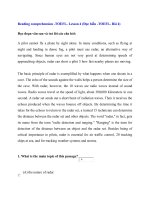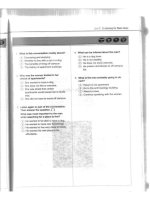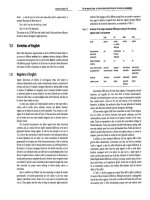Algebal review 4 pot
Bạn đang xem bản rút gọn của tài liệu. Xem và tải ngay bản đầy đủ của tài liệu tại đây (222.67 KB, 6 trang )
Types of Triangles
You can classify triangles into three categories based on the number of equal sides.
■
Scalene Triangle: no equal sides
■
Isosceles Triangle: two equal sides
■
Equilateral Triangle: all equal sides
You also can classify triangles into three categories based on the measure of the greatest angle:
■
Acute Triangle: greatest angle is acute
50°
60°
70°
Acute
Equilateral
Isosceles
Scalene
–GEOMETRY REVIEW–
109
■
Right Triangle: greatest angle is 90°
■
Obtuse Triangle: greatest angle is obtuse
Angle-Side Relationships
Understanding the angle-side relationships in isosceles, equilateral, and right triangles is essential in solving ques-
tions on the SAT.
■
In isosceles triangles, equal angles are opposite equal sides.
■
In equilateral triangles, all sides are equal and all angles are 60°.
60º
60º60º
ss
s
22
m∠a = m∠b
130°
Obtuse
Right
–GEOMETRY REVIEW–
110
■
In right triangles, the side opposite the right angle is called the hypotenuse.
Practice Question
Which of the following best describes the triangle above?
a. scalene and obtuse
b. scalene and acute
c. isosceles and right
d. isosceles and obtuse
e. isosceles and acute
Answer
d. The triangle has an angle greater than 90°, which makes it obtuse. Also, the triangle has two equal sides,
which makes it isosceles.
Pythagorean Theorem
The Pythagorean theorem is an important tool for working with right triangles. It states:
a
2
ϩ b
2
ϭ c
2
,where a and b represent the lengths of the legs and c represents the length of the hypotenuse of a
right triangle.
Therefore, if you know the lengths of two sides of a right triangle, you can use the Pythagorean theorem to
determine the length of the third side.
40°
100°
40°
66
Hypotenu
se
–GEOMETRY REVIEW–
111
Example
a
2
ϩ b
2
ϭ c
2
3
2
ϩ 4
2
ϭ c
2
9 ϩ 16 ϭ c
2
25 ϭ c
2
͙25
ෆ
ϭ ͙c
2
ෆ
5 ϭ c
Example
a
2
ϩ b
2
ϭ c
2
a
2
ϩ 6
2
ϭ 12
2
a
2
ϩ 36 ϭ 144
a
2
ϩ 36 Ϫ 36 ϭ 144 Ϫ 36
a
2
ϭ 108
͙a
2
ෆ
ϭ ͙108
ෆ
a ϭ ͙108
ෆ
a
12
6
4 c
3
–GEOMETRY REVIEW–
112
Practice Question
What is the length of the hypotenuse in the triangle above?
a. ͙11
ෆ
b. 8
c. ͙65
ෆ
d. 11
e. 65
Answer
c. Use the Pythagorean theorem: a
2
ϩ b
2
ϭ c
2
,where a ϭ 7 and b ϭ 4.
a
2
ϩ b
2
ϭ c
2
7
2
ϩ 4
2
ϭ c
2
49 ϩ 16 ϭ c
2
65 ϭ c
2
͙65
ෆ
ϭ ͙c
2
ෆ
͙65
ෆ
ϭ c
Pythagorean Triples
A Pythagorean triple is a set of three positive integers that satisfies the Pythagorean theorem, a
2
ϩ b
2
ϭ c
2
.
Example
The set 3:4:5 is a Pythagorean triple because:
3
2
ϩ 4
2
ϭ 5
2
9 ϩ 16 ϭ 25
25 ϭ 25
Multiples of Pythagorean triples are also Pythagorean triples.
Example
Because set 3:4:5 is a Pythagorean triple, 6:8:10 is also a Pythagorean triple:
6
2
ϩ 8
2
ϭ 10
2
36 ϩ 64 ϭ 100
100 ϭ 100
7
4
–GEOMETRY REVIEW–
113
Pythagorean triples are important because they help you identify right triangles and identify the lengths of
the sides of right triangles.
Example
What is the measure of ∠a in the triangle below?
Because this triangle shows a Pythagorean triple (3:4:5), you know it is a right triangle. Therefore, ∠a must
measure 90°.
Example
A right triangle has a leg of 8 and a hypotenuse of 10. What is the length of the other leg?
Because this triangle is a right triangle, you know its measurements obey the Pythagorean theorem. You could
plug 8 and 10 into the formula and solve for the missing leg, but you don’t have to. The triangle shows two parts
of a Pythagorean triple (?:8:10), so you know that the missing leg must complete the triple. Therefore, the sec-
ond leg has a length of 6.
It is useful to memorize a few of the smallest Pythagorean triples:
3:4:5 3
2
+ 4
2
= 5
2
6:8:10 6
2
+ 8
2
= 10
2
5:12:13 5
2
+ 12
2
= 13
2
7:24:25 7
2
+ 24
2
= 25
2
8:15:17 8
2
+ 15
2
= 17
2
810
?
35
a
4
–GEOMETRY REVIEW–
114









